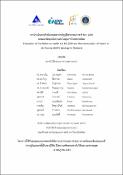บทคัดย่อ
แนวคิด “ทุกนโยบายห่วงใยสุขภาพ” หรือ Health in All Policies (HiAP) ได้ถูกกล่าวถึงในฐานะแนวคิดและหลักการ ซึ่งกำหนดอยู่ในพระราชบัญญัติสุขภาพแห่งชาติ พ.ศ. 2550 และมีการนำไปปฏิบัติอย่างเป็นรูปธรรม ยังมีช่องว่างขององค์ความรู้ คือ การประเมินบทบาทของการดำเนินงานตามพระราชบัญญัติฯ ฉบับนี้ในการนำแนวคิดทุกนโยบายห่วงใยสุขภาพมาใช้ในประเทศไทย งานวิจัยนี้มีวัตถุประสงค์เพื่อ 1) ศึกษาการทำให้แนวคิดทุกนโยบายห่วงใยสุขภาพกลายเป็นสถาบันในประเทศไทยและการปรากฏเป็นรูปธรรมนั้นส่งผลต่อการขับเคลื่อนแนวคิดผ่านกลไกในลักษณะใด และ 2) เพื่อทำความเข้าใจรากฐานและการพัฒนาแนวคิด “ทุกนโยบายห่วงใยสุขภาพ” ในสายธารการปฏิรูประบบสุขภาพของประเทศไทย เพื่อให้เกิดความเข้าใจสิ่งที่ปรากฏในปัจจุบันอย่างรอบด้านและเพื่อให้สามารถดำเนินการเพื่อการพัฒนาให้บรรลุเป้าหมายตามแนวคิดนี้ได้อย่างมีประสิทธิผลมากยิ่งขึ้น ใช้วิธีการศึกษาเชิงคุณภาพด้วยการวิจัยเอกสารและการสัมภาษณ์เชิงลึกกับผู้มีส่วนได้ส่วนเสียที่เกี่ยวข้อง จำนวน 50 คน โดยเก็บข้อมูลระหว่างเดือนเมษายนถึงกรกฎาคม พ.ศ. 2565 วิเคราะห์ข้อมูลบนฐานของการวิเคราะห์แบบ thematic analysis เพื่อค้นหาประเด็นและเรื่องราวที่สำคัญเกี่ยวกับแนวคิด “ทุกนโยบายห่วงใยสุขภาพ (HiAP)” ในพระราชบัญญัติสุขภาพแห่งชาติ พ.ศ. 2550 HiAP ปรากฏขึ้นอย่างเป็นรูปธรรมผ่านการประกาศใช้ “พระราชบัญญัติสุขภาพแห่งชาติ พ.ศ. 2550” ผ่านกลไกสำคัญ 3 ประการ ซึ่งมีข้อค้นพบ ดังนี้ 1) การปรับเปลี่ยนนิยามสุขภาพใหม่ ถูกขยายนิยามชัดเจนในหมวดสิทธิและธรรมนูญว่าด้วยระบบสุขภาพสุขภาพแห่งชาติ โดยสุขภาพทางปัญญาถือเป็นมิติสุขภาพที่เพิ่มเติมออกมาจากคำนิยามขององค์การอนามัยโลก ยังคงมีประเด็นท้าทายเพื่อให้การปรับเปลี่ยนนิยามสุขภาพใหม่เป็นที่ยอมรับและเกิดประโยชน์ต่อการดำเนินงานตามพระราชบัญญัติฯ มากขึ้น ได้แก่ การพัฒนากระบวนการและรูปแบบในการสื่อสารนิยามสุขภาพใหม่ 2) การมีส่วนร่วมของสาธารณะมีกลไกเด่นที่ทำให้เกิดการมีส่วนร่วมของสาธารณะที่ระบุในพระราชบัญญัติฯ ได้แก่ กระบวนการสมัชชาสุขภาพแห่งชาติ (มาตรา 40, 44) และการประเมินผลกระทบทางสุขภาพ (มาตรา 11) และกลไกสมัชชาสุขภาพแห่งชาติและการประเมินผลกระทบทางสุขภาพทำให้เกิดการยกระดับการมีส่วนร่วม การสร้างเครือข่ายและการเรียนรู้ร่วมกัน ประเด็นท้าทายเพื่อให้การมีส่วนร่วมมีความหมายมากยิ่งขึ้น ได้แก่ ความเป็นตัวแทนของผู้เข้าร่วมในกระบวนการอย่างแท้จริงและการใช้วิธีการที่หลากหลายเพื่อพัฒนาประเด็นนโยบายให้มีความเข้มข้นมากขึ้น 3) ความร่วมมือแบบข้ามภาคส่วนมีรูปธรรม ปรากฏอย่างเด่นชัดในหมวด 2 คณะกรรมการสุขภาพแห่งชาติ ที่ระบุองค์ประกอบรัฐระดับชาติ ท้องถิ่น สังคม วิชาการ ภายในและนอกภาคสุขภาพ นอกจากนั้นความร่วมมือแบบข้ามภาคส่วนที่ถูกออกแบบมาในพระราชบัญญัติฯ มุ่งหวังให้เกิดการประสานเชิงนโยบายผ่านผู้แทนที่มาจากภาคส่วนต่างๆ ทำให้นโยบายที่ตัดสินใจมีความชอบธรรมและสอดคล้องกับทิศทางของสังคม ประเด็นที่ท้าทาย คือ การประสานพลังเชิงนโยบายและสร้างผลกระทบควบคู่กัน ส่วนรากฐานและการพัฒนาแนวคิด HiAP นั้นเป็นผลจากการเปลี่ยนแปลงของพลวัตรการเปลี่ยนแปลงของบริบททางการเมืองและการพัฒนาด้านสุขภาพทั้งในระดับโลกและภายในประเทศที่สัมพันธ์กัน มีความเชื่อมโยงกับการก่อตัวของกลไกและเครื่องมือต่างๆ ในการพัฒนาของระบบสุขภาพตั้งแต่กระทรวงสาธารณสุข องค์การอนามัยโลก จนถึงธรรมนูญว่าด้วยระบบสุขภาพแห่งชาติ ฉบับที่ 2 ดังนั้น การพัฒนาระบบสุขภาพตามแนวคิดนี้ต้องขยายกรอบให้กว้างขวางไปกว่า พ.ร.บ. สุขภาพแห่งชาติ พ.ศ. 2550 และการปฏิบัติการของกลไกและเครื่องมือตาม พ.ร.บ. ฉบับนี้ ควรสร้างความเชื่อมโยงและการทำงานร่วมกันระหว่างองค์ประกอบทุกภาคส่วนและกลไกต่างๆ ทั้งในประเทศและต่างประเทศ โดยตระหนักร่วมกันว่าเรื่องสุขภาพนั้นกว้างขวางกว่าภารกิจขององค์กรหรือกลไกด้านสาธารณสุขหรือการดำเนินการที่เกี่ยวข้องกับสุขอนามัยเท่านั้น
บทคัดย่อ
“Health in All Policies” (HiAP) had been acknowledged as a concept and principle in the National Health Act B.E. 2550 and implemented accordingly. There was still a gap of knowledge regarding the assessment of the implementation of HiAP through the National Health Act. This article aimed 1) to explore the institutionalization and implementation of HiAP concept in Thailand, and 2) to understand the foundations and development of the concept of Health in All Policy (HiAP) in the stream of health system development in Thailand. It aims for comprehensive understanding and for more effective interventions to achieve the goals guided by this concept. This study employed a qualitative research methodology. Data collection was collected from document review and in-depth interviews with 50 key informants, between April and July 2022. Thematic analysis was used to guide data analysis. HiAP emerged concretely through the promulgation of the National Health Act, B.E. 2550 through three key mechanisms, with the following findings: 1) Redefining health was clearly expressed in Chapter I Rights and Duties in Respect of Health of the Act and in the 2nd Charter on the National Health System. Intellectual health was an extraordinary dimension of ‘health’ that was defined by the World Health Organization. There were challenges concerning the promoting of the new health definition more acceptable and beneficial to the implementation of the Act, specifically the development of processes and formats for communicating new health definitions. 2) There were prominent mechanisms for enabling public engagement identified in the Act, namely the National Health Assembly process (Section 40, 44) and health impact assessment, HIA (Section 11). The National Health Assembly and HIA mechanism created an enhanced level of participation, networking, and learning. The challenge to make participation more meaningful was the authentic representation of the participants in the process and using a variety of methods to develop better policy issues. 3) Cross-sectoral collaboration appeared prominently in Section 2 of the National Health Board that identifies the state, national, local, social, academic components within and outside the health sector. In addition, the cross-sectoral collaboration designed in the Act aimed to achieve policy coordination through representatives from various sectors, making policy decisions legitimacy and in line with the direction of society. The challenge was the synergies between policy and impact. The key findings are that the foundations and developments of the HiAP concept are the results of the interrelated dynamic change in the global and national context of politics and health development. Furthermore, they relate to the emergence of organizations, mechanisms, and tools in the development of health systems from the Thai Ministry of Public Health and World Health Organization to the Second National Health Statute. Therefore, the effort to develop a health system by the HiAP approach needs to go beyond the scope of the National Health Act B.E. 2550 and its mechanism. Also, building connections and collaboration across national and international sectors is essential, as well as emphasizing the collective awareness that health is beyond the roles of public health organizations and the interventions focus mainly on the implicit concept of sanitary.


